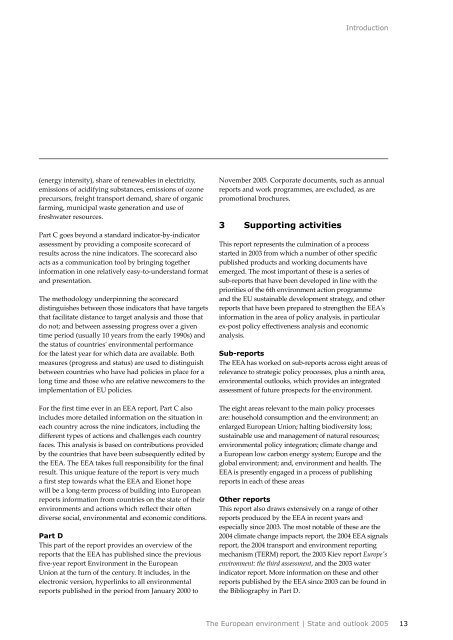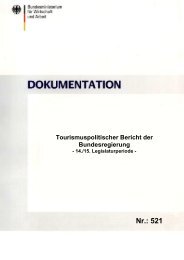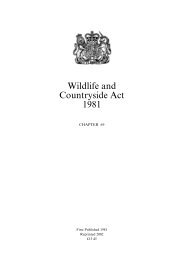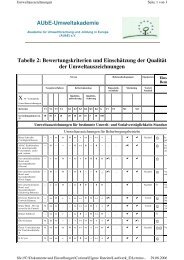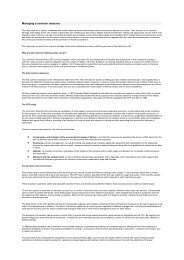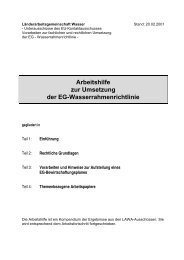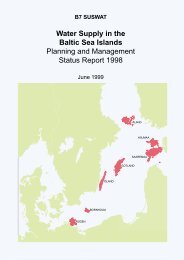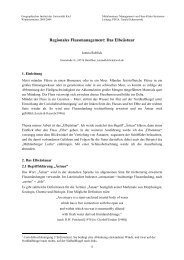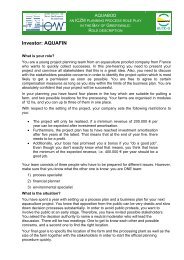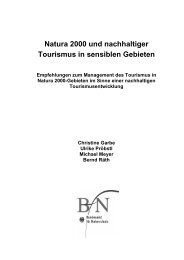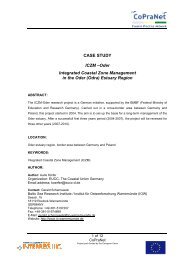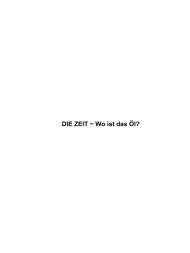The European environment - State and outlook ... - IKZM-D Lernen
The European environment - State and outlook ... - IKZM-D Lernen
The European environment - State and outlook ... - IKZM-D Lernen
Create successful ePaper yourself
Turn your PDF publications into a flip-book with our unique Google optimized e-Paper software.
Introduction<br />
(energy intensity), share of renewables in electricity,<br />
emissions of acidifying substances, emissions of ozone<br />
precursors, freight transport dem<strong>and</strong>, share of organic<br />
farming, municipal waste generation <strong>and</strong> use of<br />
freshwater resources.<br />
Part C goes beyond a st<strong>and</strong>ard indicator-by-indicator<br />
assessment by providing a composite scorecard of<br />
results across the nine indicators. <strong>The</strong> scorecard also<br />
acts as a communication tool by bringing together<br />
information in one relatively easy-to-underst<strong>and</strong> format<br />
<strong>and</strong> presentation.<br />
<strong>The</strong> methodology underpinning the scorecard<br />
distinguishes between those indicators that have targets<br />
that facilitate distance to target analysis <strong>and</strong> those that<br />
do not; <strong>and</strong> between assessing progress over a given<br />
time period (usually 10 years from the early 1990s) <strong>and</strong><br />
the status of countries' <strong>environment</strong>al performance<br />
for the latest year for which data are available. Both<br />
measures (progress <strong>and</strong> status) are used to distinguish<br />
between countries who have had policies in place for a<br />
long time <strong>and</strong> those who are relative newcomers to the<br />
implementation of EU policies.<br />
For the first time ever in an EEA report, Part C also<br />
includes more detailed information on the situation in<br />
each country across the nine indicators, including the<br />
different types of actions <strong>and</strong> challenges each country<br />
faces. This analysis is based on contributions provided<br />
by the countries that have been subsequently edited by<br />
the EEA. <strong>The</strong> EEA takes full responsibility for the final<br />
result. This unique feature of the report is very much<br />
a first step towards what the EEA <strong>and</strong> Eionet hope<br />
will be a long-term process of building into <strong>European</strong><br />
reports information from countries on the state of their<br />
<strong>environment</strong>s <strong>and</strong> actions which reflect their often<br />
diverse social, <strong>environment</strong>al <strong>and</strong> economic conditions.<br />
Part D<br />
This part of the report provides an overview of the<br />
reports that the EEA has published since the previous<br />
five-year report Environment in the <strong>European</strong><br />
Union at the turn of the century. It includes, in the<br />
electronic version, hyperlinks to all <strong>environment</strong>al<br />
reports published in the period from January 2000 to<br />
November 2005. Corporate documents, such as annual<br />
reports <strong>and</strong> work programmes, are excluded, as are<br />
promotional brochures.<br />
3 Supporting activities<br />
This report represents the culmination of a process<br />
started in 2003 from which a number of other specific<br />
published products <strong>and</strong> working documents have<br />
emerged. <strong>The</strong> most important of these is a series of<br />
sub-reports that have been developed in line with the<br />
priorities of the 6th <strong>environment</strong> action programme<br />
<strong>and</strong> the EU sustainable development strategy, <strong>and</strong> other<br />
reports that have been prepared to strengthen the EEA's<br />
information in the area of policy analysis, in particular<br />
ex-post policy effectiveness analysis <strong>and</strong> economic<br />
analysis.<br />
Sub-reports<br />
<strong>The</strong> EEA has worked on sub-reports across eight areas of<br />
relevance to strategic policy processes, plus a ninth area,<br />
<strong>environment</strong>al <strong>outlook</strong>s, which provides an integrated<br />
assessment of future prospects for the <strong>environment</strong>.<br />
<strong>The</strong> eight areas relevant to the main policy processes<br />
are: household consumption <strong>and</strong> the <strong>environment</strong>; an<br />
enlarged <strong>European</strong> Union; halting biodiversity loss;<br />
sustainable use <strong>and</strong> management of natural resources;<br />
<strong>environment</strong>al policy integration; climate change <strong>and</strong><br />
a <strong>European</strong> low carbon energy system; Europe <strong>and</strong> the<br />
global <strong>environment</strong>; <strong>and</strong>, <strong>environment</strong> <strong>and</strong> health. <strong>The</strong><br />
EEA is presently engaged in a process of publishing<br />
reports in each of these areas<br />
Other reports<br />
This report also draws extensively on a range of other<br />
reports produced by the EEA in recent years <strong>and</strong><br />
especially since 2003. <strong>The</strong> most notable of these are the<br />
2004 climate change impacts report, the 2004 EEA signals<br />
report, the 2004 transport <strong>and</strong> <strong>environment</strong> reporting<br />
mechanism (TERM) report, the 2003 Kiev report Europe's<br />
<strong>environment</strong>: the third assessment, <strong>and</strong> the 2003 water<br />
indicator report. More information on these <strong>and</strong> other<br />
reports published by the EEA since 2003 can be found in<br />
the Bibliography in Part D.<br />
<strong>The</strong> <strong>European</strong> <strong>environment</strong> | <strong>State</strong> <strong>and</strong> <strong>outlook</strong> 2005<br />
13


